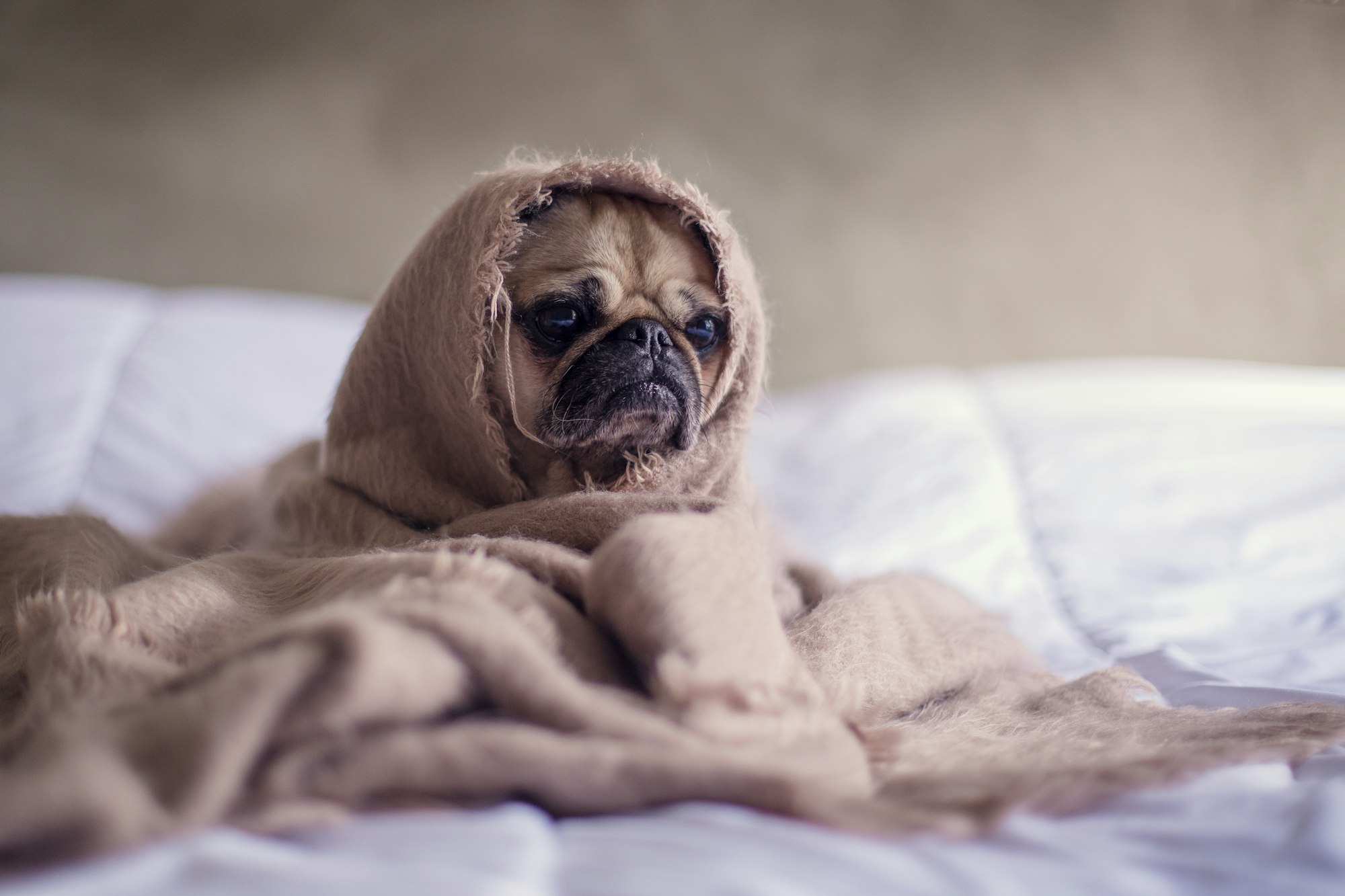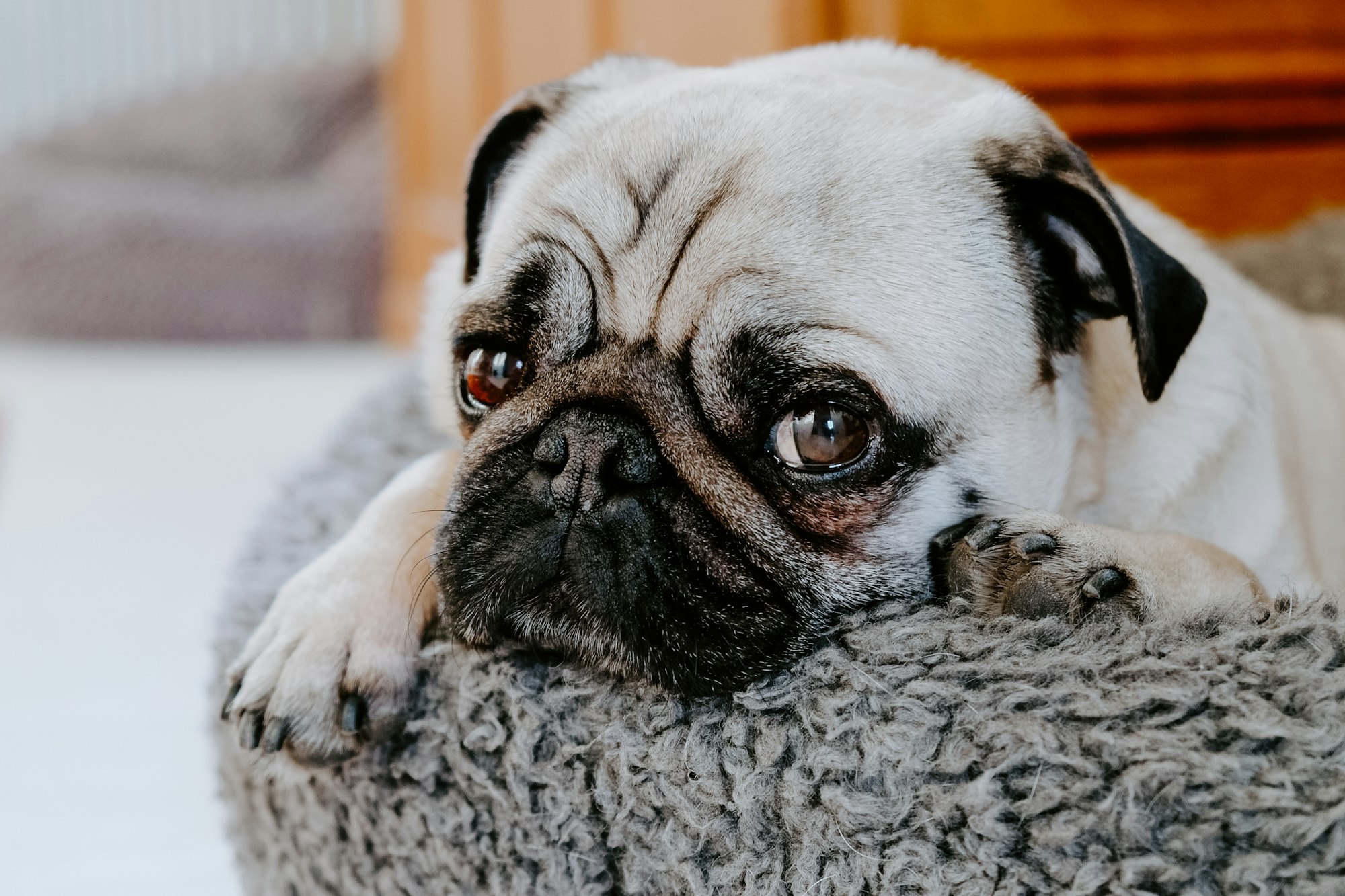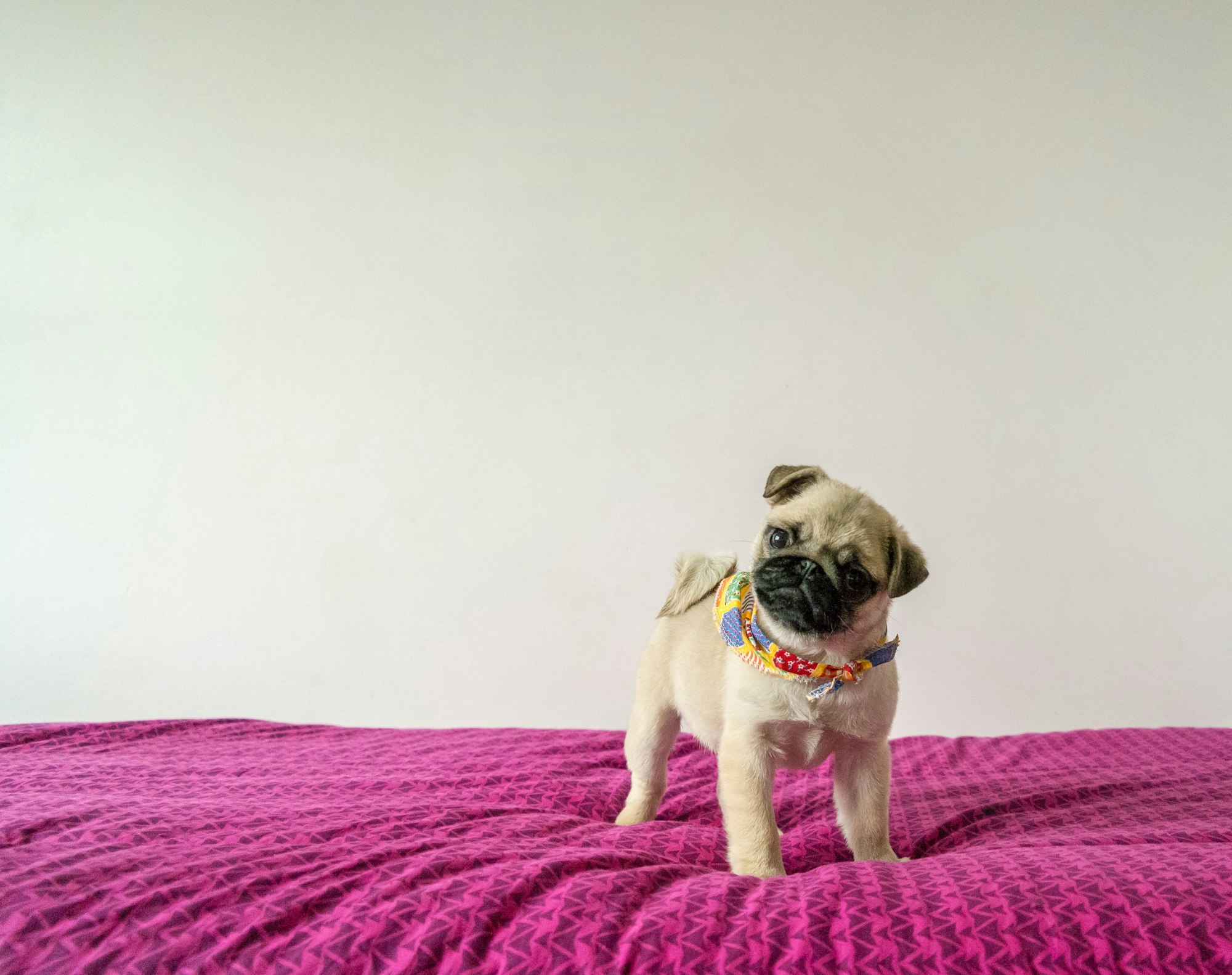Pugs, with their distinctive wrinkled faces and curly tails, are adorable and affectionate companion dogs. However, if you're considering adding a Pug to your family, it's essential to understand their grooming needs. One common concern among potential Pug owners is shedding. In this article, we will delve into the topic of Pug shedding, shedding causes, shedding management, and other related considerations. So, let's find out: do Pugs shed?

What is Pug shedding?
Pug shedding refers to the natural process in which a Pug's old or damaged hair is replaced with new hair. Shedding is a common occurrence in most dog breeds, and Pugs are no exception. While shedding is a normal part of a Pug's life cycle, some factors can influence the extent and frequency of shedding.
The shedding process in Pugs
Pugs, like many other happy dog breeds, undergo a shedding process as part of their natural hair growth cycle. Shedding is the process where old or damaged hair is replaced with new hair. Understanding the shedding process in Pugs can help you better manage their grooming needs.
Pugs have a double-layered coat consisting of a dense, soft undercoat and a coarser outer coat. Throughout the year, Pugs will shed some hair as part of their natural hair growth cycle. Shedding is a normal occurrence, and it helps maintain the health and condition of their coat.
Factors That Influence Shedding in Pugs
Several factors can influence the shedding patterns of Pugs. It's critical to be aware of these factors to understand why some Pugs may shed more than others. Here are some factors that can influence shedding in Pugs:
1. Genetics: Genetics play a significant role in determining the extent and frequency of shedding in Pugs. Some Pugs may naturally shed more than others due to their genetic makeup.
2. Health: The overall health of a Pug can affect their shedding patterns. Pugs with underlying health issues or nutritional deficiencies may experience excessive shedding or changes in their coat condition.
3. Nutrition: A proper diet is crucial for maintaining a healthy coat in Pugs. Nutritional imbalances or deficiencies can contribute to excessive shedding or a dull coat. Providing your Pug with a balanced diet that is rich in essential nutrients can help minimize shedding.
4. Environmental Factors: The environment in which a Pug lives can impact their shedding. Pugs may shed more in certain climates or seasons. Changes in temperature or humidity can influence the shedding process.
5. Stress and Hormonal Changes: Stressful situations or hormonal changes, such as pregnancy or heat cycles in female Pugs, can affect their shedding patterns. Pugs may shed more during these times.
Seasonal Shedding in Pugs

Pugs, like many other dog breeds, may experience more noticeable shedding during seasonal changes. Spring and fall are common seasons for increased shedding in Pugs.
During these periods, Pugs shed their winter coat in preparation for warmer or colder weather. Seasonal shedding helps Pugs adjust to changes in temperature and coat thickness. It's important to note that not all Pugs will experience the same degree of seasonal shedding. Factors such as genetics and overall health can influence the intensity of shedding during seasonal transitions.
To manage seasonal shedding, regular grooming is essential. Brushing your Pug's coat more frequently during shedding seasons can help remove loose hair and minimize the amount of hair that ends up around your home.
Understanding the shedding process and the factors that influence shedding in Pugs can help you better care for your furry friend. By providing proper nutrition, regular grooming, and a healthy environment, you can help minimize shedding and keep your Pug's coat in optimal condition.
Managing Pug shedding: Tips and techniques
While you can't completely eliminate shedding in Pugs, there are several effective strategies to manage it:
1. Regular grooming: Brush your Pug's coat at least once or twice a week to remove loose hair and prevent matting.
2. Bathing: Regular bathing can help minimize shedding and keep your Pug's coat clean and healthy.
3. Proper nutrition: Provide a balanced diet rich in essential nutrients, including omega-3 fatty acids, which can help promote healthy skin and coat.
4. Hydration: Ensure your Pug has access to clean water at all times to support overall skin and coat health.
5. Supplements: Consult with your veterinarian about supplements that may help maintain a healthy coat and reduce shedding.
6. Controlled environment: Keep your home clean and free of excess pet hair by regularly vacuuming and using lint rollers on furniture.
7. Professional grooming: Consider occasional visits to a professional groomer for a thorough cleaning and trimming if necessary.
Grooming practices for Pugs
Pugs have specific grooming needs that require attention:
1. Brushing: Use a soft-bristled brush or grooming mitt to remove loose hair and prevent tangles.
2. Ear cleaning: Regularly inspect and clean your Pug's ears to prevent infections.
3. Teeth brushing: Maintain good dental hygiene by brushing your Pug's teeth regularly.
4. Nail trimming: Keep your Pug's nails trimmed to a comfortable length to avoid discomfort and potential injuries.
Diet and nutrition for minimizing shedding
A healthy diet can positively impact your Pug's coat health and minimize shedding. Consider the following dietary factors:
1. High-quality dog food: Choose a well-balanced, premium dog food container product that provides essential nutrients for optimal skin and coat health.
2. Omega-3 fatty acids: Include food rich in omega-3 fatty acids, such as fish oil or flaxseed, to promote a healthy coat.
3. Hydration: Ensure your Pug stays hydrated by providing fresh water at all times.
Common misconceptions about Pug shedding
There are some misconceptions surrounding Pug shedding. Let's debunk a few of them:
1. Pugs are hypoallergenic: Pugs are not hypoallergenic and can still cause allergies in sensitive individuals.
2. Shaving reduces shedding: Shaving a Pug's coat does not reduce shedding and may interfere with their ability to regulate body temperature.
3. Shedding indicates poor health: Shedding is a natural process and does not necessarily indicate poor health. However, excessive shedding may be a sign of an underlying issue that requires veterinary attention.
Allergies and Pug shedding: Understanding the connection
Pug shedding can sometimes be a concern for individuals with allergies or sensitivities to pet hair. Understanding the connection between allergies and Pug shedding can help you make an informed decision about owning a Pug and managing allergies effectively.

The allergens that trigger allergies in sensitive individuals are typically proteins found in a dog's saliva and dander (dead skin cells). When Pugs shed their hair, these allergens can become airborne and cause allergic reactions in susceptible individuals. It's important to note that no dog breed is completely hypoallergenic, including Pugs.
However, some individuals with allergies may find that certain breeds, including Pugs, produce fewer allergens or are more tolerable compared to others.
If you or a family member has allergies and are considering getting a Pug, it's advisable to spend time with Pugs before committing to ownership. This will allow you to assess your allergic reactions and determine if a Pug is a suitable pet for you.
To manage allergies related to Pug shedding, consider the following measures:
1. Regular Grooming: Regularly grooming your Pug can help minimize shedding and reduce the amount of loose hair and allergens in your home. Brushing your Pug's coat frequently can help remove loose hair before it ends up in the environment.
2. Allergen-Free Zones: Designate certain areas of your home as allergen-free zones, such as bedrooms or specific rooms where individuals with allergies spend most of their time. Keep these areas clean and free from excessive pet hair.
3. Air Purifiers: Consider using high-quality air purifiers with HEPA filters to help remove allergens from the air. This can help improve indoor air quality and reduce the presence of pet allergens.
4. Regular Cleaning: Implement a regular cleaning routine in your home to minimize the accumulation of pet hair and allergens. Vacuuming carpets, using lint rollers on furniture, and washing bedding regularly can help reduce allergen levels.
Regular Vet Visits and Health Maintenance
Regular veterinary visits and proper health maintenance are essential for the overall well-being of your Pug. A veterinarian can guide managing shedding and address any underlying health issues that may contribute to excessive shedding.
During routine vet visits, your Pug will receive vaccinations, preventive care, and health check-ups. These visits allow the vet to monitor your Pug's health, identify any potential health concerns, and provide appropriate treatments or recommendations.
Additionally, maintaining your Pug's general health through proper nutrition, exercise, and grooming practices can positively impact their coat health and shedding. A well-balanced diet, regular exercise, and grooming routines tailored to your Pug's needs can help keep their coat healthy and minimize shedding.
By prioritizing regular vet visits and maintaining your Pug's health, you can ensure that they receive the necessary care and support for optimal shedding management and overall well-being.
Remember, if you have concerns about allergies or excessive shedding, consulting with a veterinarian is always recommended. They can provide personalized advice and guidance based on your Pug's specific needs and your circumstances.
Benefits of regular grooming
Regular grooming offers several benefits beyond managing shedding:
1. Bonding time: Grooming sessions provide an opportunity to strengthen the bond between you and your Pug.
2. Early detection of issues: Grooming allows you to spot potential skin issues, parasites, or abnormalities early on.
3. Improved coat appearance: Proper grooming helps keep your Pug's coat looking clean, shiny, and healthy.
Dealing with excessive shedding in Pugs
If your Pug is experiencing excessive shedding or if you notice any bald patches or skin irritations, it's advisable to consult with a veterinarian. Excessive shedding can be a symptom of an underlying health issue, such as allergies, hormonal imbalances, or skin infections.
Pug shedding and your home
Pug shedding can result in pet hair around your home. To manage this:
1. Regular cleaning: Vacuum your home frequently, paying attention to areas where pet hair tends to accumulate.
2. Pet-friendly furniture: Choose furniture and fabrics that are resistant to pet hair and easy to clean.
3. Lint rollers: Keep lint rollers handy to quickly remove pet hair from clothing and upholstery.
Lifestyle Considerations for Prospective Pug Owners
Before bringing a Pug into your life, consider the following factors:
1. Time commitment: Pugs require regular grooming and attention to maintain their coat and overall health.
2. Allergies: If you or a family member has allergies, spend time with Pugs before making a decision.
3. Exercise needs: Pugs have moderate exercise requirements and enjoy short walks and playtime.
4. Temperature sensitivity: Pugs are sensitive to extreme temperatures and may require extra care during hot or cold weather.
Conclusion
In conclusion, Pugs do shed, but shedding can be managed with proper grooming, nutrition, and care. Regular brushing, bathing, and a balanced diet can help minimize shedding and maintain a healthy coat. Remember that shedding is a natural process, and excessive shedding or unusual hair loss should be addressed with a veterinarian. Pugs make wonderful companions despite their shedding tendencies, so if you're prepared to put in the effort to manage their grooming needs, they can bring joy and love to your life.
Frequently Asked Questions (FAQs)
1. Q: Do Pugs shed a lot?
A: Yes, Pugs do shed. While they are not considered high-shedding dogs, they do shed moderately throughout the year.
2. Q: Are Pugs hypoallergenic?
A: No, Pugs are not hypoallergenic. They can still produce allergens that may trigger allergies in sensitive individuals.
3. Q: Can I reduce Pug shedding by shaving their coat?
A: Shaving a Pug's coat does not reduce shedding. It can disrupt their natural coat regulation and may cause other issues. Regular grooming and brushing are more effective in managing shedding.
4. Q: How often should I groom my Pug to manage shedding?
A: Regular grooming is essential for managing shedding in Pugs. Aim to brush your Pug's coat at least once or twice a week to remove loose hair and prevent matting.
5. Q: Are there any specific grooming techniques for Pugs to minimize shedding?
A: Yes, when grooming your Pug, use a soft-bristled brush or grooming mitt to remove loose hair. Pay attention to the folds of their skin, as these areas can accumulate dirt and debris. Regular bathing can also help minimize shedding and keep their coat clean.
6. Q: Can Pug shedding be a sign of an underlying health issue?
A: Excessive shedding or changes in shedding patterns can sometimes indicate an underlying health issue. If you notice severe or sudden changes in your Pug's shedding, it's advisable to consult with a veterinarian for a thorough examination.
7. Q: Can Pug shedding cause allergies in people?
A: Yes, shedding can release allergens, such as dander and saliva proteins, which may trigger allergies in susceptible individuals. Spending time with Pugs before bringing one into your home can help determine if you or your family members have any allergic reactions.
8. Q: How can I minimize pet hair around my home due to Pug shedding?
A: Regular cleaning and vacuuming can help minimize pet hair accumulation. Using lint rollers on furniture, washing bedding frequently, and keeping your Pug's grooming routine consistent can also reduce pet hair in your home.
9. Q: Can diet affect Pug shedding?
A: Yes, nutrition plays a role in maintaining a healthy coat. Providing a balanced diet with essential nutrients, including omega-3 fatty acids, can promote a healthy coat and minimize excessive shedding.
10. Q: Are there any supplements that can help reduce Pug shedding?
A: It's best to consult with a veterinarian regarding supplements for your Pug. They can recommend appropriate supplements, such as those containing omega-3 fatty acids, to support a healthy coat and minimize shedding.